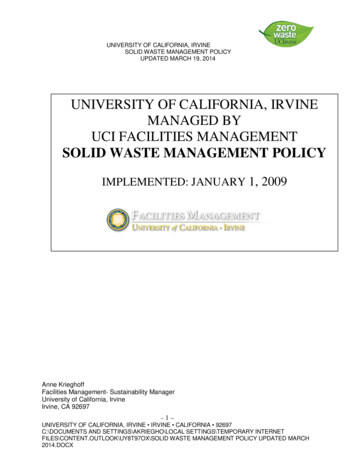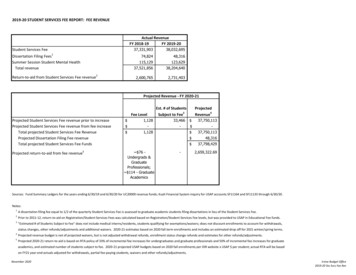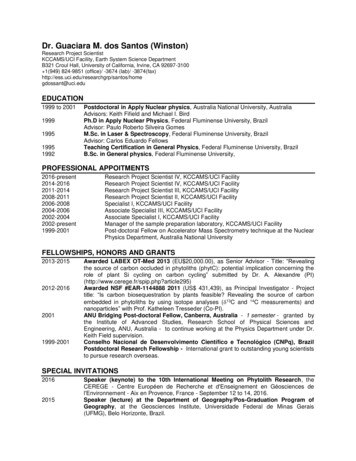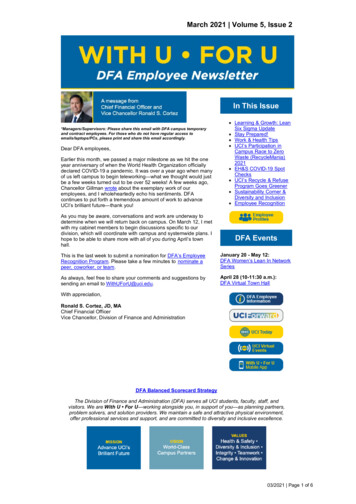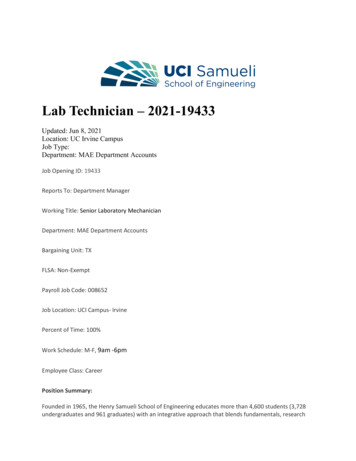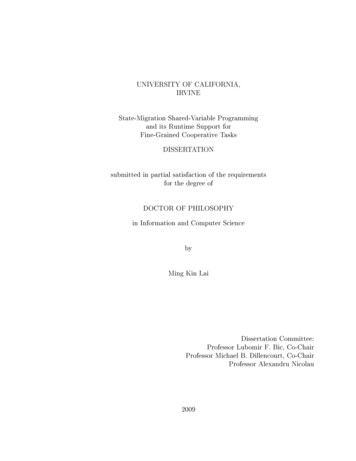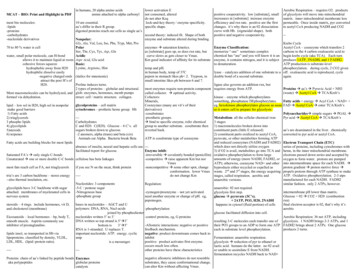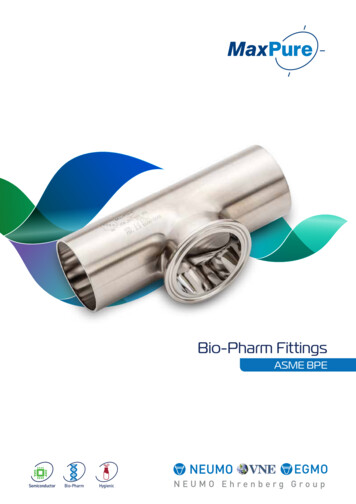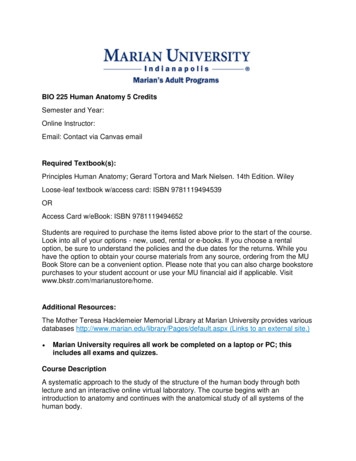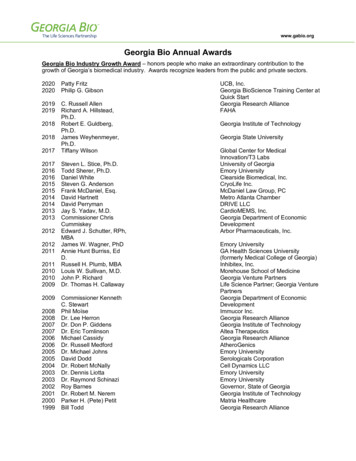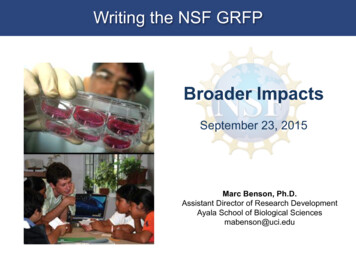
Transcription
Writing the NSF GRFPBroader ImpactsSeptember 23, 2015Marc Benson, Ph.D.Assistant Director of Research DevelopmentAyala School of Biological Sciencesmabenson@uci.edu
NSF Application Review ProcessEach application will be reviewed independently in accordance with the NSF MeritReview Criteria using all available information in the completed application.Reviewers are instructed to address the two Merit Review Criteria as approved bythe National Science Board - Intellectual Merit and Broader Impacts“Applicants must include separate statements on Intellectual Merit and BroaderImpacts in their written statements in order to provide reviewers with the informationnecessary to evaluate the application with respect to both Criteria.”Reference Broader Impacts in: Personal, Relevant Background and FutureGoals Statement (3 pages) Graduate Research Statement (2 pages) 3 Letters of Reference
NSF GRFP Review CriteriaIntellectual MeritThe IM criterion encompasses the potential to advance knowledge. Panelistsevaluating GRFP applications may consider the following: the potential of theapplicant to advance knowledge based on analysis of the completeapplication, including the personal statement, relevant background, future goals,graduate research statement, strength of the academic record, description ofprevious research experience or publication/presentations, and references.Broader ImpactsThe BI criterion encompasses the potential to benefit society and contribute to theachievement of specific, desired societal outcomes. Panelists may consider thefollowing: the potential of the applicant for future broader impacts as indicatedby personal experiences, professional experiences, educational experiencesand future plans.
NSF GRFP Review CriteriaBroader ImpactsBroader impacts may be accomplished through:1. the research itself,2. the activities that are directly related to specific research projects, or3. activities that are supported by and complementary to the project.NSF values the advancement of scientific knowledge and activities that contribute toachievement of societally relevant outcomes, such as1. full participation of women, persons with disabilities, and underrepresented minorities inscience, technology, engineering, and mathematics (STEM);2. improved STEM education and educator development at any level;3. increased public scientific literacy and public engagement with science and technology;4. improved well-being of individuals in society;5. development of a diverse, globally competitive STEM workforce;6. increased partnerships between academia, industry, and others;7. improved national security;8. increased economic competitiveness of the US; and9. enhanced infrastructure for research and education.
NSF Application Review ProcessWhat are the broader impacts of the proposed activity? How well does the activity advance discovery and understanding while promotingteaching, training, and learning? How well does the proposed activity broaden the participation ofunderrepresented groups (e.g., gender, ethnicity, disability, geographic, etc.)? To what extent will it enhance the infrastructure for research and education, suchas facilities, instrumentation, networks, and partnerships? Will the results be disseminated broadly to enhance scientific and technologicalunderstanding? What may be the benefits of the proposed activity to society?
NSF Application Review ProcessGive Specific Details for your Broader Impacts’ Activities: What do you plan to do? Why do you want to do this activity? How do you plan to accomplish your goal? How will you know if you succeed? What benefit could this Broader Impact activity accrue if the project issuccessful?
Broader Impacts - ExamplesAdvance discovery - promote teaching and learning K-12, teachers, undergrads, grads, post-docs Promote programs that will improve the transition of community collegestudents to UCIBroaden participation of underrepresented groups Education of underrepresented minorities and women Partner with minority-serving institutionsEnhance the infrastructure Emphasize partnerships and collaborationsInclude broad dissemination Partnership with museums and other similar institutions Make data available in a timely mannerBenefit society Partner with Federal Agencies and/or private sector to integrate researchinto activities of national interest Provide information for policy formulation by Federal, State or localagenciesYou can piggyback on outreach activities alreadyoccurring in your department and on campus
Outreach Activities in Bio SciVisit the Biological Sciences outreach page ch/ Bridges to Baccalaureate Program (NIH) helps minority community college students who are interestedin a biomedical career transition to a four-year university. Minority Biomedical Research Support Program (NIH) mentors minority undergraduate and graduatestudents to encourage and support them as they pursue doctoral degrees and biomedical careers. Minority Access to Research Careers Program (NIH) seeks to increase the number ofunderrepresented minority researchers in biomedical research careers by supporting junior and seniorURM students in their preparation for graduate training in the biomedical/behavioral sciences. Undergraduate Research and Mentoring Program in the Biological Sciences (NSF) has an objectiveof preparing URM undergraduates to excel in PhD programs in biological research. Minority Health and Health Disparities International Research Training Program (NIH) supportsURM students interested in studying or conducting research abroad. Minority Science Program Educational Outreach Activities The MSP maintains contact withnumerous K-12 teachers in socio-economically diverse school systems. Graduate student visits topresent a research talk or conduct an experiment or activity can be arranged. Science Fair Initiative has helped thousands of K-12 students from three Southern California schooldistricts prepare science fair projects. Teacher Professional Development Program offers summer and Saturday workshops for science andmath teachers at districts with a high proportion of minority students. DECADE Competitive Edge Summer Research Program is a summer pre-entry program geared toincoming female and minority Ph.D. students who are underrepresented in their disciplines. Participantsconduct research under the direct supervision and guidance of a UC Irvine faculty member. The programfeatures workshops and seminars designed to familiarize participants with campus resources, fosterprofessional development, and establish peer support networks.
Center for the Neurobiology ofLearning and MemoryCNLM outreach programs Become a Docent for CNLM’s school tour program Educate students about the brain using hands-on exhibits Gain teaching experience Brain Awareness Week (BAW) Visit local schools to educate students about the brain andbrain health Visit our website for more details www.cnlm.uci.edu
Outreach Activities on CampusThere are also campus-wide outreach programs at the Center for EducationalPartnerships: www.cfep.uci.edu COSMOS: California State Summer School for Mathematics & Science atwww.cosmos.uci.edu CAMP: California Alliance for Minority Participation in Science, Engineering andMathematics at www.camp.uci.edu UCI Rocket Science Tutors: http://www.rocketsciencetutors.com TechTrek Science and Math Camp for Girls: partnership between AAUW andUC Irvine - http://www.aauw-techtrek.org/uci/Work with a society or group on campus (e.g. minority associations)Expand an outreach program you were involved in as an undergraduateTalk with your advisor or “join” an outreach program that another graduate/undergraduatestudent is doing.Be creative - use of 21st-century media opportunities: Write a blog (and document hits), upload a podcast, start a Twitter feed (anddocument followers), Tumblr, Pinterest, social media
Outreach Activities off CampusGet involved with local and regional organizations: Aquarium of the Pacific Discovery Science Center Santa Ana Zoo LA Natural History Museum San Diego Zoo and Wild Animal Park Orange Country Science and Engineering Fair Orange County Science Education Association Orange County Conservation Corp Girls Inc.
Putting Broader Impacts in your ApplicationPersonal, Relevant Background and Future GoalsStatement Describe any leadership roles you have held – does nothave to be confined to the discipline that you havechosen to pursue Describe any teaching, tutoring or mentoring roles Describe general public education, K-12 outreach and/or community involvement Describe international or collaborative experiencesabroad Describe any effort to fostering diversity on all levels(across disciplines, gender, race, economic status,geography, etc.) – do you have a personal experience?
Putting Broader Impacts in your ApplicationPersonal, Relevant Background and Future GoalsStatement How did your research advance the field? How did your research impact society? How did your research promote international or interdisciplinarycollaborations? How was your research disseminated to the community? Did you do research or presentations abroad? How did your research have an impact on underrepresentedminorities or promote women in science? Did you mentor/teach/tutor anybody? Were you involved in broader impact programs at yourUniversity? Did you have any leadership roles in your lab?
Putting Broader Impacts in your ApplicationBEFORE: My broad interests are in global environmental sustainability and education. Ihave spent time in a number of developing countries and during 2010 I volunteered inGuatemala for three weeks. I worked with an organization called Ecolibri, addressingcommunity and environmental health.AFTER: I lived in Haiti during a significant portion of my childhood and spent time in anumber of developing countries, experiences that have contributed toward my broadinterests in global environmental sustainability and education. In 2010, I volunteered inGuatemala for three weeks working with an organization called Ecolibri that addressescommunity and environmental health in the Lake Atitlan area. The lake, which manylocals rely on as a water source, is threatened by pollution from tourists and a growingpopulation. I worked on a recycling and community cleanup project using plastic bottlesstuffed with trash as building material for fences and inner house walls. In addition Ihelped and learned from the local environmental health and water manager, Carlos. Oneday as we worked to collect water samples and measure bacterial growth, in the spacewhich serves as his office, laboratory, and meeting room, I asked Carlos what heperceives are the biggest challenges for his community. He didn’t think twice beforeresponding, education. Volunteering in Guatemala gave me a glimpse of different lifeperspectives, a practical application of common laboratory techniques, as well asemphasizing the importance of community outreach and education.
Putting Broader Impacts in your ApplicationGraduate Research Plan Statement How will your research advance the field?How will your research impact society? Will your research promote international or interdisciplinary collaborations?Will you do research or presentations abroad? How will your research be disseminated to the community? How will your research have an impact on underrepresented minorities orpromote women in science? Will you mentor, teach or tutor anybody? Do you plan to be actively involved in the community? Will you develop an outreach project that relates to your research project orfield? Will you creatively integrate research and education? Will you or have you become involved in broader impact programs at yourUniversity? Will you have any leadership roles in your lab?
Putting Broader Impacts in your ApplicationIN SUMMARY: Be thorough – provide specificexamples and evidence Utilize existing resources Be creative Partner and collaborate
Describe any teaching, tutoring or mentoring roles Describe general public education, K-12 outreach and/ or community involvement Describe international or
